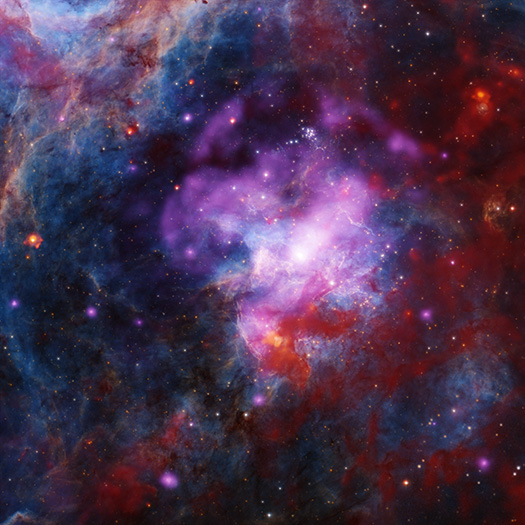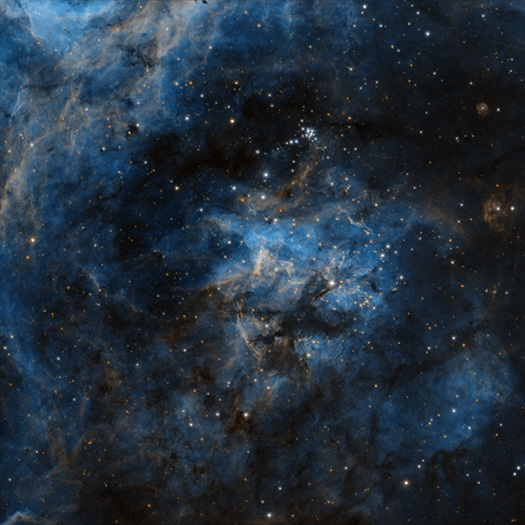
From The National Aeronautics and Space Administration Chandra X-ray telescope
1.3.24
Megan Watzke
mwatzke@cfe.harvard.edu
Chandra X-ray Center
Cambridge, Mass.
617-496-7998
Jonathan Deal
jonathan.e.deal@nasa.gov
Marshall Space Flight Center
Huntsville, Ala.
256-544-0034

Composite

X-ray

Optical

Infrared
_______________________________
X-rays from Chandra have provided evidence for at least two explosions tied to the supernova remnant 30 Doradus B.
Typically, there is only one supernova associated with a supernova remnant.
30 Doradus B is found in the Large Magellanic Cloud, a small neighbor galaxy to the Milky Way.
A new image of 30 Doradus B contains X-rays, optical, and infrared data.
_______________________________
A colorful, festive image shows different types of light containing the remains of not one, but at least two, exploded stars. This supernova remnant is known as 30 Doradus B (30 Dor B for short) and is part of a larger region of space where stars have been continuously forming for the past 8 to 10 million years. It is a complex landscape of dark clouds of gas, young stars, high-energy shocks, and superheated gas, located 160,000 light-years away from Earth in the Large Magellanic Cloud, a small satellite galaxy of the Milky Way.
 The European Southern Observatory [La Observatorio Europeo Austral] [Observatoire européen austral][Europaiche Sûdsternwarte] (EU)(CL)’s VISTA telescope reveals a remarkable image of the LMC- Large Magellanic Cloud.
The European Southern Observatory [La Observatorio Europeo Austral] [Observatoire européen austral][Europaiche Sûdsternwarte] (EU)(CL)’s VISTA telescope reveals a remarkable image of the LMC- Large Magellanic Cloud.
The new image of 30 Dor B was made by combining X-ray data from NASA’s Chandra X-ray Observatory (purple), optical data from the Blanco 4-meter telescope in Chile (orange and cyan), and infrared data from NASA’s Spitzer Space Telescope (red). Optical data from NASA’s Hubble Space Telescope was also added in black and white to highlight sharp features in the image.



A team of astronomers led by Wei-An Chen from the National Taiwan University in Taipei, Taiwan, have used over two million seconds of Chandra observing time of 30 Dor B and its surroundings to analyze the region. They found a faint shell of X-rays that extends about 130 light-years across. (For context, the nearest star to the Sun is about 4 light-years away). The Chandra data also reveals that 30 Dor B contains winds of particles blowing away from a pulsar, creating what is known as a pulsar wind nebula.

When taken together with data from Hubble and other telescopes, the researchers determined that no single supernova explosion could explain what is being seen. Both the pulsar and the bright X-rays seen in the center of 30 Dor B likely resulted from a supernova explosion after the collapse of a massive star about 5,000 years ago. The larger, faint shell of X-rays, however, is too big to have resulted from the same supernova. Instead, the team thinks that at least two supernova explosions took place in 30 Dor B, with the X-ray shell produced by another supernova more than 5,000 years ago. It is also quite possible that even more happened in the past.
This result can help astronomers learn more about the lives of massive stars, and the effects of their supernova explosions.
The paper led by Wei-An Chen describing these results was recently published in The Astronomical Journal. The co-authors of the paper are Chuan-Jui Li, You-Hua Chu, Shutaro Ueda, Kuo-Song Wang, Sheng-Yuan Liu, all from the Institute of Astronomy and Astrophysics, Academia Sinica, in Taipei, Taiwan, and Bo-An Chen from National Taiwan University.
See the full article here .
Comments are invited and will be appreciated, especially if the reader finds any errors which I can correct. Use “Reply” at the bottom of the post.

five-ways-keep-your-child-safe-school-shootings
Please help promote STEM in your local schools.
NASA’s Marshall Space Flight Center in Huntsville, Ala., manages the Chandra program for NASA’s Science Mission Directorate in Washington. The Smithsonian Astrophysical Observatory controls Chandra’s science and flight operations from Cambridge, Mass.
In 1976 the Chandra X-ray Observatory (called AXAF at the time) was proposed to National Aeronautics and Space Administration by Riccardo Giacconi and Harvey Tananbaum. Preliminary work began the following year at NASA’s Marshall Space Flight Center and the Harvard Smithsonian Center for Astrophysics. In the meantime, in 1978, NASA launched the first imaging X-ray telescope, Einstein (HEAO-2), into orbit. Work continued on the AXAF project throughout the 1980s and 1990s. In 1992, to reduce costs, the spacecraft was redesigned. Four of the twelve planned mirrors were eliminated, as were two of the six scientific instruments. AXAF’s planned orbit was changed to an elliptical one, reaching one third of the way to the Moon’s at its farthest point. This eliminated the possibility of improvement or repair by the space shuttle but put the observatory above the Earth’s radiation belts for most of its orbit. AXAF was assembled and tested by TRW (now Northrop Grumman Aerospace Systems) in Redondo Beach, California.
AXAF was renamed Chandra as part of a contest held by NASA in 1998, which drew more than 6,000 submissions worldwide. The contest winners, Jatila van der Veen and Tyrel Johnson (then a high school teacher and high school student, respectively), suggested the name in honor of Nobel Prize–winning Indian-American astrophysicist Subrahmanyan Chandrasekhar. He is known for his work in determining the maximum mass of white dwarf stars, leading to greater understanding of high energy astronomical phenomena such as neutron stars and black holes. Fittingly, the name Chandra means “moon” in Sanskrit.
Originally scheduled to be launched in December 1998, the spacecraft was delayed several months, eventually being launched on July 23, 1999, at 04:31 UTC by Space Shuttle Columbia during STS-93. Chandra was deployed from Columbia at 11:47 UTC. The Inertial Upper Stage’s first stage motor ignited at 12:48 UTC, and after burning for 125 seconds and separating, the second stage ignited at 12:51 UTC and burned for 117 seconds. At 22,753 kilograms (50,162 lb), it was the heaviest payload ever launched by the shuttle, a consequence of the two-stage Inertial Upper Stage booster rocket system needed to transport the spacecraft to its high orbit.
Chandra has been returning data since the month after it launched. It is operated by the SAO at the Chandra X-ray Center in Cambridge, Massachusetts, with assistance from Massachusetts Institute of Technology and Northrop Grumman Space Technology. The ACIS CCDs suffered particle damage during early radiation belt passages. To prevent further damage, the instrument is now removed from the telescope’s focal plane during passages.
Although Chandra was initially given an expected lifetime of 5 years, on September 4, 2001, NASA extended its lifetime to 10 years “based on the observatory’s outstanding results.” Physically Chandra could last much longer. A 2004 study performed at the Chandra X-ray Center indicated that the observatory could last at least 15 years.
In July 2008, the International X-ray Observatory, a joint project between European Space Agency [La Agencia Espacial Europea] [Agence spatiale européenne][Europäische Weltraumorganisation](EU), NASA and Japan Aerospace Exploration Agency (JAXA) (国立研究開発法人宇宙航空研究開発機構], was proposed as the next major X-ray observatory but was later cancelled. ESA later resurrected a downsized version of the project as the Advanced Telescope for High Energy Astrophysics (ATHENA), with a proposed launch in 2028.
 European Space Agency [La Agencia Espacial Europea] [Agence spatiale européenne][Europäische Weltraumorganisation](EU) Athena spacecraft depiction
European Space Agency [La Agencia Espacial Europea] [Agence spatiale européenne][Europäische Weltraumorganisation](EU) Athena spacecraft depiction
On October 10, 2018, Chandra entered safe mode operations, due to a gyroscope glitch. NASA reported that all science instruments were safe. Within days, the 3-second error in data from one gyro was understood, and plans were made to return Chandra to full service. The gyroscope that experienced the glitch was placed in reserve and is otherwise healthy.
The National Aeronautics and Space Administration (NASA) is the agency of the United States government that is responsible for the nation’s civilian space program and for aeronautics and aerospace research.
President Dwight D. Eisenhower established the National Aeronautics and Space Administration (NASA) in 1958 with a distinctly civilian (rather than military) orientation encouraging peaceful applications in space science. The National Aeronautics and Space Act was passed on July 29, 1958, disestablishing NASA’s predecessor, the National Advisory Committee for Aeronautics (NACA). The new agency became operational on October 1, 1958.
Since that time, most U.S. space exploration efforts have been led by NASA, including the Apollo moon-landing missions, the Skylab space station, and later the Space Shuttle. Currently, NASA is supporting the International Space Station and is overseeing the development of the Orion Multi-Purpose Crew Vehicle and Commercial Crew vehicles. The agency is also responsible for the Launch Services Program (LSP) which provides oversight of launch operations and countdown management for unmanned NASA launches. Most recently, NASA announced a new Space Launch System that it said would take the agency’s astronauts farther into space than ever before and lay the cornerstone for future human space exploration efforts by the U.S.
NASA science is focused on better understanding Earth through the Earth Observing System, advancing heliophysics through the efforts of the Science Mission Directorate’s Heliophysics Research Program, exploring bodies throughout the Solar System with advanced robotic missions such as New Horizons, and researching astrophysics topics, such as the Big Bang, through the Great Observatories [NASA/ESA Hubble, NASA Chandra, NASA Spitzer, and associated programs.] NASA shares data with various national and international organizations such as from [JAXA]Greenhouse Gases Observing Satellite.


